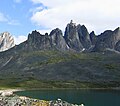| Mount Monolith | |
|---|---|
 Summit centered, west aspect | |
| Highest point | |
| Elevation | 2,165 m (7,103 ft) [1] |
| Prominence | 444 m (1,457 ft) [2] |
| Parent peak | Tombstone Mountain [3] |
| Isolation | 4.43 km (2.75 mi) [2] |
| Coordinates | 64°25′36″N138°31′35″W / 64.42667°N 138.52639°W [4] |
| Naming | |
| Etymology | Monolith |
| Geography | |
 | |
| Interactive map of Mount Monolith | |
| Location | Yukon, Canada |
| Protected area | Tombstone Territorial Park [3] |
| Parent range | Ogilvie Mountains [2] |
| Topo map | NTS 116B7 Tombstone River |
| Geology | |
| Rock age | Cretaceous |
| Rock type | Granite |
Mount Monolith is a mountain in Yukon, Canada.



